Contents
- General description of momordica charantia
- Nutritional value, composition and calorie content of bitter melon
- What is useful momordica charantia
- Application in folk medicine
- Cooking application
- Preparation for medicinal purposes
- Limitations and contraindications
- Rules for growing momordica charantia
- Conclusion
A plant with an exotic name momordica charantia and with no less bizarre fruits today often adorns balconies and loggias. In the Crimea and in the Krasnodar Territory, it is grown in open ground, right in the garden.
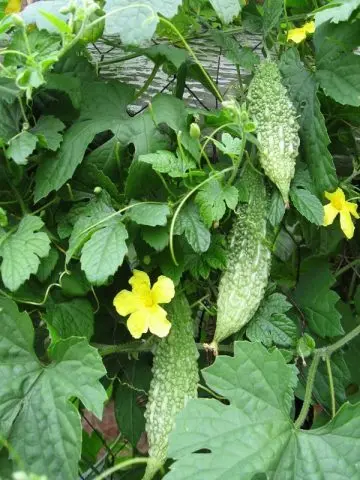
A plant with an unusual appearance has delicious pericarp in its mature form, in addition, it is distinguished by its beneficial properties. It is believed that the love of the Japanese for momordica is one of the reasons for their long life expectancy.
General description of momordica charantia
The birthplace of Chinese bitter melon, or momordica charantia, is the tropics of Asia. The plant has the appearance of a vine, reaching four meters in length.
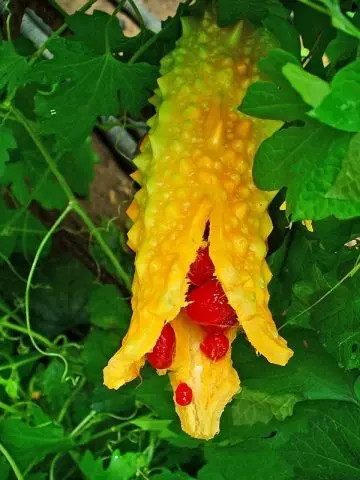
The stem of the plant is pentagonal, with grooves and tendrils clinging to the support.
The leaves of momordica charantia have from five to nine lobes, at the base they are heart-shaped, the shape is kidney-shaped or flattened, they are arranged alternately. The petiole is about 5 cm long.
Flowers with five yellow petals, unisexual, are in the axils of the leaves.
The stem of the plant is long. In the immature state, the fruits of momordica charantia are green and bright orange – in the ripeness phase. Their surface is rough, covered with “warts”, wrinkles. The name of the plant reflects the type of its fruits: in the translation of momordica, charantia means “bite of an animal.” The shape of the fruit is cylindrical, externally and in size they resemble cucumbers. The pulp is bitter, juicy, dense.

Inside the fruit of momordica charantia, each seed is in a juicy pericarp, which has a ruby color and a great taste, reminiscent of persimmon. Seeds at the stage of full maturity are brown in color, have an oval or rectangular shape.
Nutritional value, composition and calorie content of bitter melon
The unripe fruits are eaten. Mature ones are bitter, excluding the pericarp, enveloping the seeds of momordica charantia. To remove bitterness, the fruits are soaked and then stewed, fried, used for canning.
The composition of the plant includes a large number of vitamins, macro- and microelements, antioxidant substances. Of the vitamins in 100 g of fruits, momordica charantia includes:
- V1 (thiamine) – 0,04 mg;
- B3 (niacin, nicotinic acid) – 0,4 mg;
- B6 (pyridoxine) – 0,043 mg;
- A (alpha and beta carotenes) – 0,375 mcg;
- C (ascorbic acid) – 84,0 mg.
The composition of macro- and microelements per 100 g of fruits (in mg):
- Potassium – 296;
- Calcium – 19;
- Magnesium – 17;
- Sodium – 5;
- Phosphorus – 31;
- Iron – 0,43;
- Manganese – 0,089;
- Copper – 0,034;
- Selenium – 0,2;
- Zinc – 0,8;
The energy value of 100 g of momordica charantia is 17 kcal. In its composition:
- Proteins – 1,0 g;
- Fats – 0,17 g;
- Carbohydrates – 3,7 g;
- Dietary fiber – 2,8 g.
What is useful momordica charantia
Due to the high content of iron, calcium, potassium, beta-carotene, momordica charantia has a beneficial effect on the body:
- stimulating digestion;
- stimulating appetite;
- providing preventive and curative effect in case of malaria;
- helping to treat HIV and in the destruction of pancreatic cancer cells;
- helping to lower blood sugar;
- improving the condition of the skin and hair;
- preventing the formation of cholesterol plaques;
- alleviating the condition with rheumatoid arthritis, joint pain;
- slowing down the aging process.
Daily inclusion in the diet of momordica charantia leads to the normalization of metabolic processes, stimulation of smooth weight loss, and increased energy. For this reason, the fruits of the plant are used in dietetics. In different countries of the world, momordica charantia has been used to treat:
- infections of the gastrointestinal tract – in China;
- malaria, diarrhea, measles, hepatitis – in South America;
- liver disease, snakebite in India.
Application in folk medicine
In folk medicine of South America, all parts of momordica charantia are used – fruits, leaves, roots, juice. Tincture and decoction is used as an anti-cold, immunomodulatory agent. Crushed leaves are applied to abscesses, wounds, burns. Seeds are consumed raw for the prevention of cardiovascular pathologies, lowering the level of “bad” cholesterol.
From the root of momordica charantia, an expectorant is prepared that helps with bronchitis. The sap of the plant is poisonous, but it is used to treat skin diseases.

Traditional healers use a decoction for nephritis, prostatitis, kidney stones.
Momordica charantia extract destroys streptococci and staphylococci, resists HIV.
To prepare the tincture you need:
- Finely chop the fruits of momordica charantia.
- Fill a glass container with crushed pieces.
- Pour in vodka.
- Insist in a dark cool place for 2 weeks.
To use the prescription, you need to consult a doctor.
A decoction of the seeds of momordica charantia is used for hemorrhoids, fever, and also as a diuretic. Prepare it as follows:
- Grind 15 – 20 seeds.
- Pour the mixture with boiling water.
- Maintain on low heat for 10 minutes.
- Insist 1 hour.
- Filter.
The use of momordica charantia in diabetes mellitus
There is no consensus in official medicine about the effect of preparations from momordica charantia on blood glucose levels and the general condition of diabetic patients. In the course of research, it was found that the effect of the plant does not affect everyone equally. In some patients, an effect similar to the action of insulin preparations is noted, in others it is equal to zero. Therefore, during treatment, preparations based on momordica charantia should be used only as an adjuvant.
Medical supervision is required when using the plant as a food supplement or in the form of preparations based on momordica charantia.
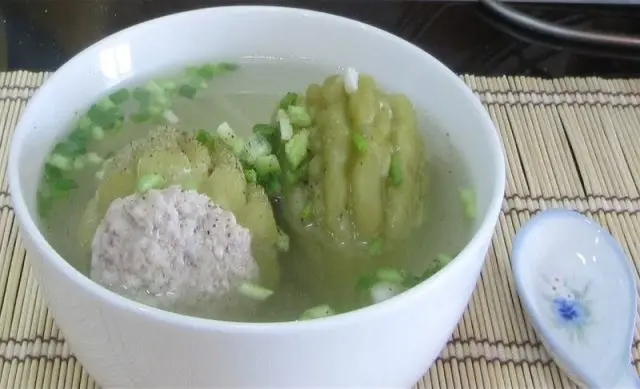
Cooking application
In Asian countries, momordica charantia is the basis of many national dishes. Due to the high content of protein and vitamins, the plant is used in the preparation of soups, snacks, salads. Young leaves and shoots contain folic acid. The fruits are consumed both unripe and mature, but they have different astringency and sharpness of taste. Large fruits are especially tasty if they are fried. Momordica charantia is good with stew, strong broth, marinated. Thanks to its fruits, the taste of dishes becomes piquant.
In Indian cuisine, bitter melon is one of the main components of curry seasoning. Together with herbs, it is added to meat and fish dishes.
Prepared from momordica and jam with an unusual taste. By adding alcohol to the composition of the sweet mass, liqueurs or tinctures are obtained from the fruits.
Sweet pericarp is used in baking buns, cookies, cakes.
Preparation for medicinal purposes
Procurement of raw materials from momordica charantia has its own characteristics.
In May, during the period of plant formation, leaves should be collected, fruits – in summer, seeds and roots – in autumn.
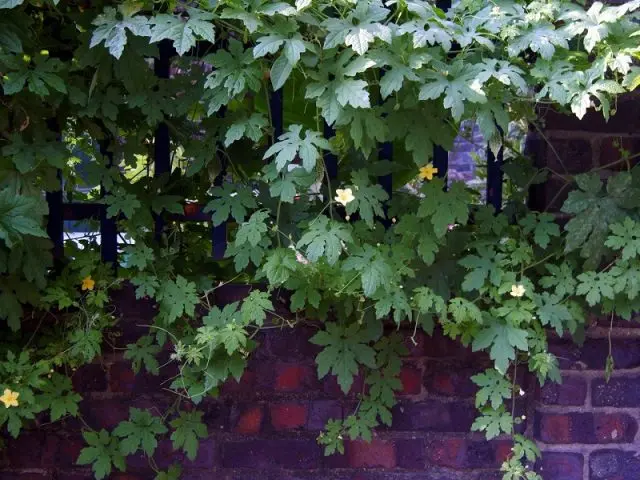
To determine the degree of ripeness of the fruit, it is worth paying attention to the color of the valves, from which the seeds of momordica charantia are visible.
As with the harvesting of any medicinal plant, the drying process must be organized in such a way that the raw material does not rot and at the same time the sun does not fall on it.
Stems, seeds and leaves are harvested whole. The fruits are finely chopped before drying.
All prepared raw materials should be stored in cloth or paper bags, in glassware. The properties of the plant are preserved for several years after harvest:
- flowers and leaves – 2 years;
- rhizomes – 3 years;
- fruits – 4 years.
Limitations and contraindications
Despite the beneficial medicinal properties of momordica, it has a number of contraindications for external and internal use. These include:
- pregnancy, since the plant contains substances that can lead to miscarriage;
- the period of breastfeeding;
- allergic reaction to the plant;
- overdose of use.
With great care, it is worth using the product for gastric and duodenal ulcers.
Hypothyroidism, thyrotoxicosis, pathology of the adrenal glands are the reason for the partial restriction in the use of momordica charantia.
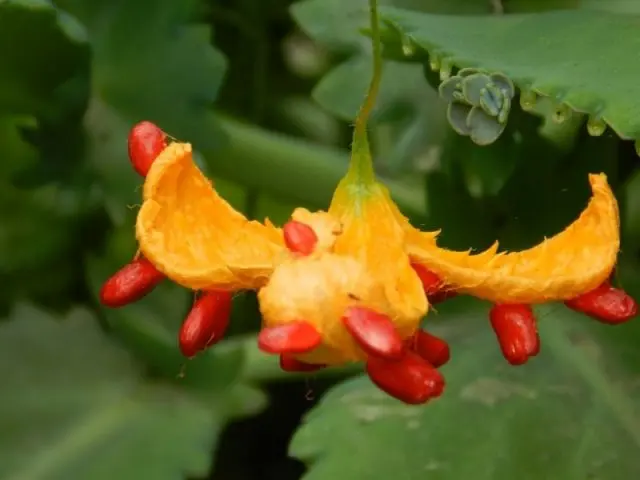
Adverse reactions to bitter melon include:
- nausea;
- vomiting;
- rash;
- itching;
- sore throat;
- fever;
- hypoglycemia.
Toxins in the composition of momordica charantia can cause coma, severe poisoning of the body.
Before the fruit appears, the leaves of the plant can cause burns. After the appearance of the first fruits, this property disappears.
Rules for growing momordica charantia
According to reviews of exotic plant lovers, bitter melon can be successfully grown in a greenhouse, on a balcony, loggia, and even on a windowsill, as a houseplant.
Oddly enough, but the short summer of central Our Country is quite enough for a tropical liana to fully mature. For cultivation, some nuances should be taken into account.
The seeds of the plant are large – 11 by 8 mm, flat, with rounded edges and a bumpy surface. The skin is hard and dense. Seeds need to be scarified for germination. It consists in scratching the sharp tip of the seed with sandpaper, after which it will open and germinate more easily. Seeds are disinfected with a dark solution of potassium permanganate, where they must be placed for several hours. For germination, disinfected seeds of momordica charantia are laid out on a damp cloth, sawdust and transferred to a warm place where the air temperature is -25 ⁰С. Under these conditions, germination is 100%.
After the appearance of the first roots, the seeds are placed in the ground or pots. Seedlings develop better if the soil contains leaf humus, peat, sand in a ratio of 2: 1: 0,5.
Momordica charantia requires constant feeding, which responds to rapid growth and development. Organic fertilizers must be applied even when digging – up to 10 kg per 1 sq. m. Mineral – in the amount of 30 g of ammonium nitrate, 40 g of superphosphate and 30 g of potassium chloride per 1 sq. m. At high acidity values, lime is useful in the amount of 400 g per 1 sq. km. m.
When growing momordica charantia on a balcony in boxes, it is worth considering the volume of soil and calculating the amount of complex fertilizer based on the volume of the container.
Conclusion
Momordica charantia is not a very common plant, however, it is gradually gaining popularity. This is due to its medicinal properties, taste, interesting appearance. It is worth being very careful about the use of bitter melon, because, along with the advantages, it has many contraindications. The study of the properties, characteristics, characteristics of the plant, combined with the advice of a doctor, will help make its use error-free, bringing maximum benefit.









